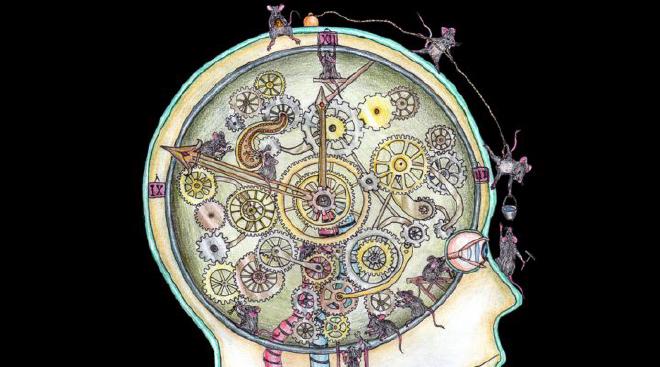

Guido’s research line is based on elucidating how the circadian system is capable of modulating cellular metabolism as well as the course of different diseases. In particular, it studies how the biological clock works in tumor cells, as well as in their treatment. “Taking into account the timing of drug administration can be a great tool to optimize treatment efficiency. In some studies from the group, we have found that, both in cultured tumor cells and in mouse tumors, the internal clock is capable of modulating tumor growth and its treatment, determining differences in the survival of these animals according to the timing of drug administration, as well as reducing adverse effects. This means that they can respond differentially to certain therapies with specific medications, depending on the time of day they are administered,” explains Guido. The group’s latest article on this topic was recently published in the journal Cellular and Molecular Life Sciences from the Nature group.
The path of chronobiology #
The research line led by Guido falls within the field of “chronobiology.” It opens the promising door not only to administering medications at the optimal time but also to using lower treatment doses and reducing adverse effects caused by aggressive therapies, such as chemotherapy. In his scientific training, Guido began studying the metabolism of the retina in response to light, and during his postdoctoral work, he focused on investigating the suprachiasmatic nuclei in nocturnal animals, nuclei that are located above the “optic chiasm” where the projections from the retina to the brain cross. “The retina sends visual information to the brain, which not only processes images but also detects the light that sets the biological clock every day and controls other functions not directly associated with vision, such as the pupillary reflex and the inhibition of the nighttime hormone melatonin,” details Guido.
“Through the suprachiasmatic nucleus, the brain informs the entire body whether it is day or night, or whether it is time to be awake, to eat, and even to regulate body temperature. To summarize it in one concept, these nuclei are the ones that temporally organize the behavior and physiology of living beings,” he points out. One of the most recent discoveries in his field of study was the finding that not only does the brain regulate the biological clock, but that most cells in an organism’s body have small clocks that synchronize with the central clock through the coordination of the suprachiasmatic nucleus. “Previously, it was thought that the clock was only in the retina, in the pineal gland, and in this nucleus,” clarifies Guido. “But now it is known that, in peripheral organs such as the heart, liver, intestines, muscles, and almost all individual cells, there is the ability to measure time.”
These clocks synchronize exactly every 24 hours through external signals, such as light, but also through others produced by food, physical activity, temperature, among others. Once those clocks are set, the cells are able to measure time and organize their activity based on that. In 2017, for the discovery of how the circadian clock works at the molecular level in most organisms - from flies to humans - scientists Jeffrey C. Hall, Michael Rosbash, and Michael W. Young won the Nobel Prize in Medicine.
At that time, Guido’s laboratory began to wonder what happens to the biological clock in tumor cells. Would it be altered in these sick cells? Would the functioning of its biological clock suffer changes? “In living beings and their cells, disruptions or destabilizations are generated by modern life. Factors such as continuous artificial lighting in large cities and the use of LED lights and various electronic devices like notebooks, tablets, cell phones, televisions, among others, which send light signals to the brain at night, mainly blue light from the visible spectrum, cause the normal functioning of the biological clock to become unregulated. Transmeridian flights or continuous rotating shifts in night work are also disturbances that alter the functioning of this internal clock and generate a greater propensity for diseases such as cancer, metabolic syndrome, obesity, type 2 diabetes, digestive problems, and other pathologies,” explains the scientist.
Instructions to set the clock #
After several studies, scientists found that, especially in very aggressive brain tumors, the sick cells still maintain the ability to oscillate throughout the day, meaning that their biological clock continues to function in them despite their primary function being altered. “That finding was important because it opened the door for us to test times of the day when the tumor cell may be more susceptible to chemotherapy under oncological treatment or to a particular medication, as well as a bacterium to be treated with an antibiotic. What times? Generally, they are those moments when the metabolism of that cell is more active,” says Guido.
Deepening the line of study in chronobiology, they studied the moments of greater or lesser proliferation and viability of tumor cells after being synchronized with external signals, but also in retinal and liver cells under physiological or tumor conditions, specifically in liver cancer. “This led us to investigate more recently with colleagues from Bahía Blanca, the scientists from the Institute of Biochemical Research of Bahía Blanca, Cecilia Bouzat and Gabriela Salvador, and also the scientist Andrea Smania, from our same institute, these oscillatory behaviors in lipid metabolism and cellular bioenergetics, and to verify that there is a sustained oscillatory response over time with a period in the circadian range, in different types of cells, including tumor cells. This phenomenon is observed throughout evolution, from bacteria, through invertebrates, such as certain types of worms, to mammals. In our experiments, the various types of cells had the ability to generate self-sustained rhythms in their lipid droplet metabolism,” says Guido.
Knowing that cancer cells have a functional intrinsic biological clock that regulates metabolic parameters led them to wonder if this clock can be manipulated to make chemotherapy more effective. “In breast cancer, for example, we know from studies from another laboratory that cells metastasize more predominantly at night. In that case, chemotherapy is more effective at night. In the case of brain tumors such as glioblastomas, which are very invasive tumors that present a poor prognosis after diagnosis and have had little effective therapies to date, we have been testing various chemotherapies with drugs that act at different levels in the cancer cell in order to improve treatment and combine them to achieve a more effective effect. We are looking for a chronotherapeutic treatment that acts during the time windows when the drug is most effective. We observed in cultured cells and in experimental animal models that, depending on the drug, there is a differential time window of greater susceptibility.”
For Guido, all these studies demonstrate that “the circadian system has a direct impact on tumor growth but also on chemotherapy. It goes hand in hand with the fact that the immune system changes throughout the day. Cortisol, which is the hormone that sends the alert and stress signal, rises early in the morning, while body temperature fluctuates over the 24 hours. All these parameters cause the body to respond differently at one time of day than at another,” he assures. “Continuing with this line of research is essential in order to improve current therapies or find new combinations of drugs that allow for the modulation of the biological clock and, in this way, achieve more effective and less toxic treatments for patients,” Guido concludes.
Bibliographic references #
-
Wagner, P. M., Salgado, M. A., Turani, O., Fornasier, S. J., Salvador, G. A., Smania, A. M., … & Guido, M. E. (2024). Rhythms in lipid droplet content driven by a metabolic oscillator are conserved throughout evolution. Cellular and Molecular Life Sciences, 81(1), 348. DOI: 10.1007/s00018-024-05355-4
-
Adessi, T. G., Wagner, P. M., Bisogno, F. R., Nicotra, V. E., Guido, M. E., & García, M. E. (2024). Enhancing structural diversity through chemical engineering of Ambrosia tenuifolia extract for novel anti-glioblastoma compounds. Scientific Reports, 14(1), 14229. 10.1038/s41598-024-63639-y
-
Adessi, T. G., Wagner, P. M., Bisogno, F. R., Nicotra, V. E., Guido, M. E., & García, M. E. (2024). Enhancing structural diversity through chemical engineering of Ambrosia tenuifolia extract for novel anti-glioblastoma compounds. Scientific Reports, 14(1). https://doi.org/10.1038/S41598-024-63639-Y
-
Monjes, N. M., Wagner, P. M., & Guido, M. E. (2022). “Disruption of the molecular clock severely affects lipid metabolism in a hepatocellular carcinoma cell model.” Journal of Biological Chemistry, 298(11), 102551. https://doi.org/10.1016/J.JBC.2022.102551
-
Wagner, P. M., Fornasier, S. J., & Guido, M. E. (2024). Pharmacological Modulation of the Cytosolic Oscillator Affects Glioblastoma Cell Biology. Cellular and Molecular Neurobiology, 44(1). https://doi.org/10.1007/S10571-024-01485-2
-
Wagner, P. M., Monjes, N. M., & Guido, M. E. (2019). Chemotherapeutic Effect of SR9009, a REV-ERB Agonist, on the Human Glioblastoma T98G Cells. ASN Neuro, 11, 175909141989271. https://doi.org/10.1177/1759091419892713
-
Wagner, P. M., Prucca, C. G., Velazquez, F. N., Sosa Alderete, L. G., Caputto, B. L., & Guido, M. E. (2021). Temporal regulation of tumor growth in nocturnal mammals: In vivo studies and chemotherapeutical potential. FASEB Journal : Official Publication of the Federation of American Societies for Experimental Biology, 35(2), e21231. https://doi.org/10.1096/fj.202001753R
-
Wagner, P. M., Prucca, C. G., Caputto, B. L., & Guido, M. E. (2021). Adjusting the Molecular Clock: The Importance of Circadian Rhythms in the Development of Glioblastomas and Its Intervention as a Therapeutic Strategy. International Journal of Molecular Sciences 2021, Vol. 22, Page 8289, 22(15), 8289. https://doi.org/10.3390/IJMS22158289
-
Wagner, P. M., Salgado, M. A., Turani, O., Santiago, ·, Fornasier, J., Salvador, G. A., Smania, A. M., Bouzat, C., Guido, M. E., & Wagner, P. M. (2024). Rhythms in lipid droplet content driven by a metabolic oscillator are conserved throughout evolution. Cellular and Molecular Life Sciences 2024 81:1, 81(1), 1–15. https://doi.org/10.1007/S00018-024-05355-4
-
Wagner, P. M., Sosa Alderete, L. G., Gorné, L. D., Gaveglio, V., Salvador, G., Pasquaré, S., & Guido, M. E. (2018). Proliferative Glioblastoma Cancer Cells Exhibit Persisting Temporal Control of Metabolism and Display Differential Temporal Drug Susceptibility in Chemotherapy. Molecular Neurobiology. https://doi.org/10.1007/s12035-018-1152-3

